Chapter 14
The Meta-lexicon of Activities Involved in Analyzing the Textual Object
14.1. Introduction
Having discussed the meta-lexicon which is reserved for the conceptual vocabulary needed to describe the objects of analysis* that make up the universe of discourse*, let us now take a look at that which identifies the activities of analysis we use when describing, annotating and indexing an audiovisual text or corpus.
As we shall specify in the following section (14.2), we have concentrated on four particular classes of activity of analysis which, together, form a second meta-lexicon of conceptual terms. That is, they form an entirely separate metalinguistic resource, which the concept designer uses to specify and develop the models of description* that make up the library of models for describing the universe of discourse* peculiar to a given audiovisual archive. The analyst uses these procedures to carry out his task of analysis or assessment of an audiovisual text or corpus.
In sections 14.2–14.6, we shall introduce the main categories of analytical procedures which we employ when processing an audiovisual corpus.
Every activity of analysis defined in the ASW meta-lexicon is accounted for by one or more schemas of indexing – a schema of indexing is one or more specialized fields which the analyst must or may fill in when analyzing his audiovisual text or corpus. In section 14.7, we shall discuss the relations of definition between one or more schemas of indexing and a conceptual term identifying a descriptive activity (or rather, a specific type of descriptive activities). Then, we shall give a very brief presentation of the library of indexing schemas which we were able to develop during the ASW-HSS project
14.2 Four categories of textual analysis activities
Remember our discussion in Chapter 13: every model of description* (accessible to the analyst via a specialized working interface) is made up of one or more sequences of description*, each one being functionally specialized in the progressive elucidation of the subject*, the theme of an audiovisual discourse (i.e. a discourse expressed and communicated essentially through image and sound). A sequence, in turn, is made up of at least two schemas of definition*, i.e. two small generic configurations, one of which specifies the object of analysis* in a descriptive sequence* and the other the procedures of analysis*.
We are aware of two basic procedures for analyzing an audiovisual text or corpus: the so-called free procedure* and the so-called controlled procedure*. In the so-called free procedure, the analyst freely (as indicated by the appellation “free description”) “fills in” the fields making up his working interface. These fields depend directly on the structure of the descriptive model being used, and the analyst is invited to fill these in order to produce a concrete description of the object of his analysis. In the case of the controlled procedure, a thesaurus* (or rather, a microthesaurus* interpreting the range of possible values for a conceptual term* or configuration of conceptual terms) enables the analyst to choose one or more values (standardized expressions or descriptors) which best represent the specificity of the object of his analysis – hence the expression “controlled description”. Throughout this book, we have seen concrete examples which illustrate these two procedures (see Chapters 3, 9 and 10, for instance).
That said, the main analytical tools which we have created and which we currently use to work concretely on the content of an audiovisual text or corpus are divided as follows:
– linguistic tools (lato sensu) grouped around the explicitation, description and indexation of the content of an audiovisual text or passage therein;
– audiovisual tools grouped around the explanation/illustration of the content using visual or acoustic expressions such as icons, emoticons, jingles, etc., which in this particular case thereby acquire the status of metalinguistic data describing (or rather, illustrating) an object of analysis;
– tools grouped around the translation/adaptation, explicitation, etc. of a textual object in a target language different from the one used to produce the object in question;
– tools grouped around the use of thesauruses, socio-taxonomies (“folksonomies”), glossaries, terminologies (be they personal, institutional, etc.) to identify and classify the textual object;
– tools serving to bring an ASW analysis closer to a standard or a norm (such as the LOMFR, Dublin Core, etc.);
– tools (of critical analysis) enabling us to comment on, criticize, improve, enrich, etc. content.
Alongside the tools for segmenting relevant audiovisual passages, and those for actually publishing an analyzed and indexed audiovisual corpus, the tools of analysis we have just cited constitute a rich and diverse arsenal, which we believe facilitates a satisfactory appropriation of any audiovisual object to make it into a resource sui generis, aimed at a specific audience (see our explanations in Chapter 1).
Figure 14.1 shows the general organization of the meta-lexicon which begins with the primitive conceptual term [Procedure of analysis]. This meta-lexicon is divided into four major taxonomical classes of analytical procedures.
The first class of procedures covers all the activities which allow us to treat the various aspects of an audiovisual text or corpus. As explained in Chapter 1, we consider the audiovisual text as being made up of a set of characteristic levels (or strata) such as that of the referential thematization of a knowledge object, the syntagmatic development of an object being thematized, the discursive and audiovisual framing, etc.
Figure 14.1. The four classes of activities in analyzing an audiovisual text or corpus
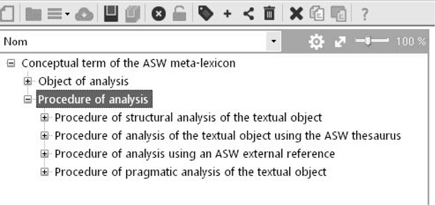
Besides the fact that an audiovisual text is an object made up of a series of characteristic strata, it is also an object which can be broken down into smaller units. These include, on the one hand, general textual units such as the unit [Segment], the unit [Transition] or the narrative unit [Sequence] and, on the other hand, named and typed textual units (i.e. which represent a specific genre of units) such as the unit [Opening credits], [Closing credits], [Insert], etc.
However, along with the potential to break an audiovisual text into smaller units, analyzing these different strata is the main task of this first category of analytical activities represented by the conceptual term [Procedure of structural analysis of the textual object].
A second class of procedures (Figure 14.1) is represented by the root conceptual term [Procedure of analysis of the textual object using the ASW thesaurus]. It includes all analytical activities which are carried out using one or more microthesauruses belonging to the ASW shared thesaurus (also see Chapters 10 and 15).
The next category – the third (Figure 14.1), represented by the conceptual term [Procedure of analysis using an ASW external reference] – is given over to all analytical activities which use thesauruses, terminologies, ontologies or indeed standards which are external to the ASW system. In summary, these allow the analyst, if he so desires, to carry out analyses of an audiovisual corpus using not the ASW shared thesaurus but another thesaurus, a terminology of his own choosing.
The fourth and final category of procedures (Figure 14.1) includes all analytical activities which enable us to adapt the textual object to a particular audience (addressee) or use. It begins with the root conceptual term [Procedure of pragmatic analysis of the textual object].
In the next section, we shall give a more detailed discussion of these four major classes which, currently, are rather unequally developed. The activities of the first two classes – [Procedure of structural analysis of the textual object] and [Procedure of analysis of the textual object using the ASW thesaurus] – are the most advanced. As regards the activities of the third class – [Procedure of analysis using an ASW external reference] – we have contented ourselves with a few isolated tests of practical feasibility rather than actually developing a whole arsenal of specific activities. Finally, the fourth class did not constitute a central issue for research and development as part of the ASW-HSS project.
14.3. The class of activities [Procedure of structural analysis of the textual object]
Figures 14.2 and 14.3 show an extract from the conceptual vocabulary identifying the main types of activities for analyzing the textual object as a structural unit.
Figure 14.2. The procedure of content analysis performed on the textual object
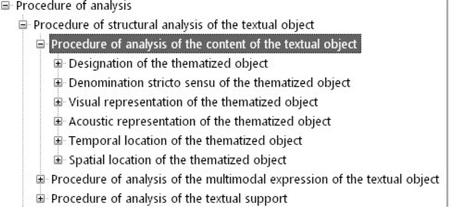
Thus, we can distinguish three main taxonomic domains represented by the conceptual terms [Procedure of analysis of the content of the textual object] (see Figure 14.2), [Procedure of analysis of the multimodal expression of the textual object] (see Figure 14.4) and [Procedure of analysis of the textual support] (again, see Figure 14.4).
As we can see, in developing this conceptual vocabulary, we did not use our usual canonic triplet of [Taxon of the domain…], [Feature of the domain…] and [System of the domain…]. The reason behind this omission is purely pragmatic in nature: we have no need of it, as the hierarchy of conceptual terms for this vocabulary is far less complex than that representing the objects of analysis* in the ASW universe of discourse* (see Chapter 13). That said, in time this vocabulary will also be transformed, in a manner entirely similar to the conceptual vocabulary representing the analytical objects, in a hierarchy of taxonomic domains.
Looking at Figure 14.2 more closely, we can clearly see that the conceptual term [Procedure of analysis of the content of the textual object] can be broken down into a whole series of specialized activities.
The two first groups of these more specialized activities are identified by the conceptual terms [Designation of the thematized object (in an audiovisual text)] and [Denomination stricto sensu of the thematized object]. They are given over to the linguistic activity of (free) indexation to identify and name a knowledge object which is the subject in an audiovisual text being analyzed. We have seen some concrete examples during out discussion about the procedure of free description*.
Without wishing to go into detail, let us at least point out that these two groups of procedures for analyzing the content include a whole variety of even more specialized analytical activities. Thus, in terms of [Designation of the thematized object], amongst other things, we find the following activities which we have already come across in our concrete examples (see e.g. those in Chapters 3 and 9):
– [Minimal designation of the thematized object] (and its pragmatic variants);
– [Contextualized designation of the thematized object] or;
– [Designation of the thematized object by keywords].
In terms of the [Denomination stricto sensu of the thematized object] (Figure 14.2), we find all the analytical operations which require the analyst to produce proper nouns which are appropriate to identify, e.g.:
– the name of a natural expanse or place (a flow of water, a geographical outcrop, etc.);
– the name of a product or brand;
– the name and acronym of an institution or indeed;
– the ethnonym of a people or an ethnic group.
Finally, we also find here the analytical activity of [Anthroponymic denomination] (and its different variants) to identify a person by his/her/their different names (surname, first name, patronym, matronym, nickname, etc.).
Two other groups of activity belonging to the taxonomic domain [Procedure of analysis of the content of the textual object] (Figure 14.2) are represented by the conceptual terms [Visual representation of the thematized object] and [Acoustic representation of the thematized object]. The activities which fall under this taxonomic domain offer the analyst the possibility of indexing the content of an audiovisual text, not with linguistic expressions (the option which is made available to the analyst by the analytical activities belonging to the two first groups cited above), but instead with visual and/or acoustic expressions. An able and experienced analyst can thus create a whole meta-iconography peculiar to his archive, to represent such-and-such a type of subjects, this-or-that theme of discourse. This is certainly a very original and inventive way of creating visual and/or sonic interfaces for accessing the content of an archive…
Figure 14.3. Access (only in French) to the filmic collection of an audiovisual archive via Google Maps (e.g. the ArkWork archives – Arkeonauts’ Workshop)

The two last groups of the taxonomic domain [Procedure of analysis of the content of the textual object] (Figure 14.2) are represented by the conceptual terms [Temporal location of the thematized object] and [Spatial location of the thematized object]. As their appellations indicate, they include a series of activities enabling the analyst, if applicable, to identify a thematized object’s geographical coordinates and the dates (precise or approximate) which punctuate its existence over time.
The geographic and temporal data collected by the analyst or generated automatically by the ASW system1 (see [GUE 11] for further information) are used, amongst other things, to facilitate access to an archive’s filmic collection via interactive geographical maps and timelines. Thus, for instance, a good part of the audiovisual collection belonging to the archives developed as part of the ASW-HSS project is accessible through Google Maps and timelines2 (see Figure 14.3, which shows access to the audiovisual collection of the ArkWork archives through Google Maps – available only in French).
Figure 14.4. The procedure of analyzing the multimodal expression and the support of the textual object
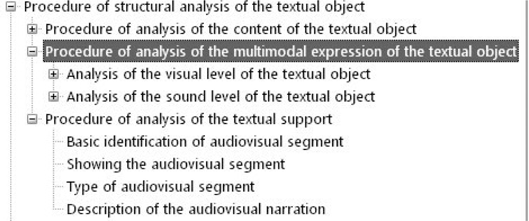
As Figure 14.4 shows, the taxonomic domain initiated by the conceptual term [Procedure of structural analysis of the textual object] can again be broken down – in addition to the set of analytical procedures devoted to the content of an audiovisual text – into two other sets of analytical activities. The first of these is represented by the conceptual term [Procedure of analyzing the multimodal expression of the textual object]; the second by the conceptual term [Procedure of analysis of the textual support].
The set of activities represented by the root conceptual term [Procedure of analyzing the multimodal expression of the textual object] serves for analyzing the visual and/or audiovisual language. For instance, one might analyze the visual (or acoustic) framing of a thematized object, the visual field and what is on or off camera, the visual (and acoustic) shots, etc.
The activities which fall under the root conceptual term [Procedure of analysis of the textual support] serve for identifying relevant segments in an audiovisual text, for cutting the audiovisual text up into smaller units and for describing and classifying these units.
14.4 The class of activities [Procedure of analysis of the textual object using the ASW thesaurus]
Figure 14.5 shows an extract from the fairly complex organization of the set of activities which make up the procedure of controlled description* (see Chapter 10), i.e. the procedure which, unlike free description* (see Chapter 11), relies on the use of one or more thesauruses* (micro-thesauruses).
Figure 14.5. The procedure of analysis of the textual object using the ASW thesaurus
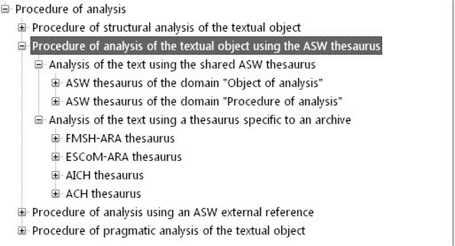
In the figure, we see a bipartite organization based on the notion of microthesauruses and the distinction between shared micro-thesauruses, common to all audiovisual archives which use the ASW metalinguistic resources* and private micro-thesauruses, specific to an audiovisual archive, i.e. to the universe of discourse* of a particular audiovisual archive. A micro-thesaurus is composed of:
– a facet, i.e. a semantic trait (or, as we prefer to term it, a classeme in the sense of structural semantics [GRE 66]) and;
– a (hierarchical) list of controlled expressions (i.e. a terminology) which constitute the values of the facet.
Thus, for instance, the controlled expression <18th Century>, along with other uses, may belong to a micro-thesaurus which simply contains a list of temporal units dividing the chronological axis into arbitrary periods of 100 years; but it may also belong to a micro-thesaurus of eras in the history of France, where it denotes an era rather than an arbitrary chronological zoning.
We still use a whole series of micro-thesauruses in order to be able to describe and index objects thematized in the universe of discourse* of a given audiovisual archive. Thus, we have at our disposition a whole series of micro-thesauruses to chronologically locate an object thematized* in the most varied of audiovisual corpora*.
Yet it is clear that the universe of discourse of a given audiovisual archive has its own semantic specificities, be they referential or discursive, which must be taken into account. For instance, an audiovisual archive devoted to Andean intangible cultural heritage (in Peru and Bolivia)3, needs a fairly precise micro-thesaurus of geographical location (territorial, administrative, ethnic, linguistic, etc.) which draws upon the vocabulary from the ASW thesaurus but classifies those terms in a facet specific to the universe of discourse in question. This micro-thesaurus might prove useful for another archive. If so, it will be made available to the new archive, but one considers rather that it answers to the particular needs of a specific group of users or archives, or indeed a specific collection of archives. The analytical activity which uses it is therefore classed under the root conceptual term [Analysis of the text using a micro-thesaurus specific to an archive] (see Figure 14.5).
14.5 The class of activities [Procedure of analysis using an ASW external reference]
Figure 14.6 shows the third class of procedures, entitled [Procedure of analysis using an ASW external reference]. This category of analysis has a very strategically important function because it offers the analyst the chance to use the ASW working environment (i.e. the ASW Studio, comprising the three workshops of Segmentation, Description and Publication of audiovisual corpora) while carrying out concrete analyses in reference to standards, thesauruses or other languages external to the ASW universe. Thus, one analyst can carry out a description which conforms to the LOMFR norm; another can produce a description in accordance with the Dublin Core standard, and so on.
Figure 14.6. The procedure of analysis of the textual object using an external reference
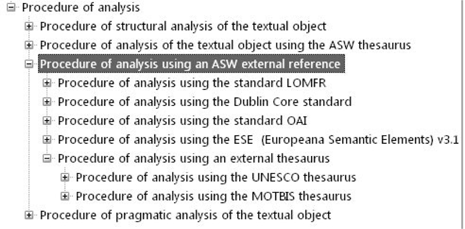
Let us take the example of the description of an audiovisual text or corpus using a model of description* which integrates the LOMFR standard. Such a description serves, amongst other things, to explicitize and classify audiovisual texts (or of specific passages within an audiovisual text) from an educational point of view and taking account of the potential interest of the object being analyzed for a specific pedagogical use. In other words, and seen from the ASW’s point of view, it is a question of producing:
– first an analysis either of the content (the subject*) of an audiovisual text (or specific passage within that text) or of the audiovisual language (i.e. the audio and visual shots);
– and then an evaluation of the content or audiovisual language analyzed in light of the particular criteria of the LOMFR norm.
Figure 14.7 shows an extract of the first part of that analysis, which consists of the description of the content of an audiovisual passage thematizing traditional bread-baking in north-eastern Portugal.4
Figure 14.7. First part of the working interface facilitating a description in reference to the LOMFR norm: description of the object
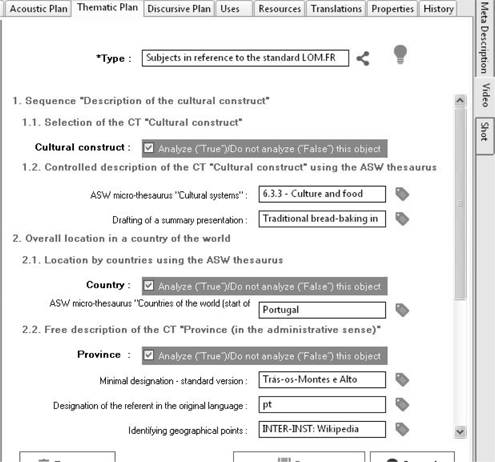
By supplementing this first description with a second, consisting of a standardized procedure of evaluation of the specific educational/pedagogical relevance of the analyzed content, the analyst not only contributes to a better diffusion/accessibility of the audiovisual text being analyzed, but also to a better appreciation of it as a pertinent pedagogical resource by the actors involved (teachers, trainers, etc.). This is illustrated by Figure 14.8, where we only see the beginning of the entering of information needing to be collected with a view to making a description conform to the LOMFR standard.
Thus, going back to our example, the working interface partially shown in Figures 14.7 and 14.8 would enable us to (fairly easily) establish a pedagogical collection which conforms to the LOMFR standard and which would offer the interested audience (teachers, trainers, etc.) cultural subjects in the form of audiovisual documents, to be used as part of a particular teaching program, corresponding to a particular level, for a particular category of learners, favoring a particular teaching style, and so on.
Figure 14.8. Second part of the working interface enabling the user to enter a description in reference to the LOMFR standard: beginning of the description in accordance with the LOMFR standard
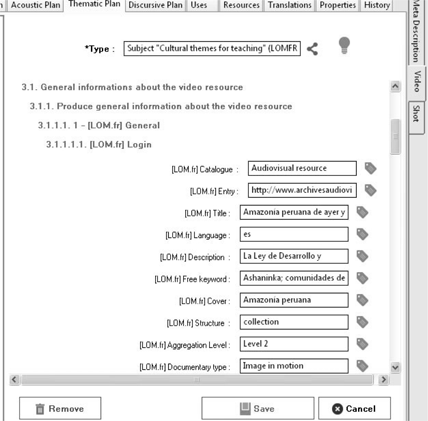
Returning once more to Figure 14.6, we can clearly see that the class of descriptive activities currently available to carry out analyses in accordance with a reference external to the ASW system is not overly well developed. As has already been mentioned, our primary objective was to study and test the possibility of endowing the ASW system with models of description* that take account of such references. Time will tell how this class of analytical activity evolves. Besides the particular case of the LOMFR standard, for now (as Figure 14.6 shows), we are primarily interested in providing the analyst with the option of carrying out descriptions of audiovisual content which is likely to be (re-)diffused on the major portals for sharing cultural and scientific heritage, which often integrate standards such as Dublin Core or OAI.
14.6 The class of activities [Procedure of pragmatic analysis of the textual object]
Finally, Figure 14.9 shows the three main groups of analytical activity which make up the taxonomic domain [Procedure of pragmatic analysis of the textual object]. Under the umbrella of the conceptual term [Procedure of translation of the textual object], we classify all activities which serve to render an audiovisual text accessible to an audience who do not possess the linguistic skills needed to understand it.
As we have already explained in previous publications ([STO 08] and [STO 10]), this is a question of opening up an audiovisual text which is usually monolingual to a “knowledge market” that, for its part, is intrinsically multilingual. This does not necessarily entail producing professional translations (in the form of dubbing, subtitling, etc.) for every audiovisual text – which, at least from a financial standpoint, is practically impossible. Rather, it involves offering linguistic mediation services such as relay translation or communal translation, enabling an analyst/ translator, in the language of the target audience, to produce explanatory notes and summaries, translations in the telegraphic sense, or more or less free versions.5
Figure 14.9. The procedure of pragmatic analysis of the textual object
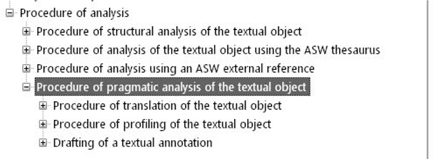
The root conceptual term [Procedure of profiling of the textual object] (Figure 14.9), encompasses the activities which enable the analyst to play the role of cultural mediator between the specific identity of a given audiovisual text and the identity of its audience, their framework of cultural references, their expectations and, finally, their cognitive skills. In concrete terms, these activities are carried out in the form of commentaries, explanations, usage instructions and aids, location of bibliographical or webographical references, etc.
The final group of activities represented by the root conceptual term [Drafting of a textual annotation] comprises a small set of very general activities whose aim, as the conceptual term suggests, is to enable the analyst to produce textual notices which explain his work of analysis.
Here we find the case of the famous meta-description, presented in greater detail elsewhere [CHE 11a]. The meta-description is not a description of the audiovisual object but rather an explanation, provided by the analyst, of the content and objectives of his own work of analysis or assessment. Indeed, as developed in [CHE 11a], there are clearly a great many types of analysis: from the simplest, most rudimentary description to a “true” expert assessment of an audiovisual text, through documentalist- and librarian-type descriptions. Of course, it is up to the analyst to outline his own analytical task and to provide the elements enabling the specificity of his work to be appreciated. The small group of activities included under the conceptual term [Drafting of a textual annotation] offer the analyst the possibility of carrying out such an explanatory task.
14.7 Activity of analysis and schemas of indexation
Every activity of analysis (or description) is defined by one or more so-called schemas of indexing*. A schema of indexing is made up of one or more fields for information input.
Figure 14.10 shows the relatively complex organization which underlies every analytical activity. It also illustrates the partial similarity and the difference between a conceptual term representing an object of analysis* (i.e. which belongs to the conceptual vocabulary [Object of analysis]) and a conceptual term representing an activity of analysis (i.e. which belongs to the conceptual vocabulary [Procedure of analysis]).
Thus, as stated above, all analytical activities are defined by one or more schemas of indexation. This fact is exemplified in Figure 14.11, which shows the analytical activity entitled [Minimal designation of the thematized object – standard form]. This activity is made up of three schemas of indexing:
i) the schema of indexing Entering of the minimal expression, which enables the analyst to “physically” enter the linguistic expression – usually nominal – which he deems appropriate to designate the object thematized in his text);
Figure 14.10. Relations between schemas of indexing and the two meta-lexicons of conceptual terms in the ASW universe of discourse
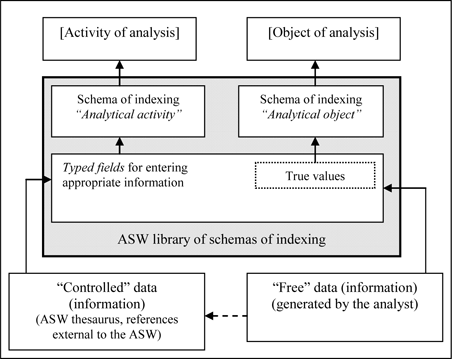
ii) the schema of indexing Linguistic category (of minimal expression), which enables the analyst to specify whether the minimal expression he has entered is, e.g. a simple noun, a compound noun, a nominal syntagm, a fixed expression, etc.;
Figure 14.11. The activity [Designation] and interpretation of it using schemas of indexing

iii) the schema of indexation Collection of relevant information on Wikipedia, which enables the analyst, if he so desires, to indicate the URL of a Wikipedia article where the ASW system can glean further information about the object in question; as previously explained, this service – which is currently only available in English – is particularly useful for harvesting geographical and/or temporal data which can be used to access an audiovisual collection by way of a geographical map and/or timeline).
Figure 14.12 shows the aspect of the activity [Minimal designation of the thematized object – standard form] thus defined when the analyst uses it to carry out a concrete description.
Figure 14.12. Working interface defining the activity [Minimal designation of the thematized object – standard form]
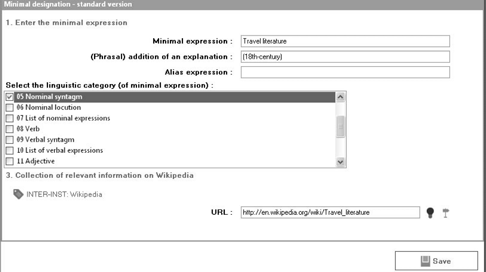
Let us stress, therefore, that the results of a specific analytical operation are defined by so-called schemas of indexing. As laid out in Chapter 1 (section 1.4), the term “indexation” must be understood here in a very broad sense, i.e. in terms of any concrete result, of the physical output from an analysis in the form, for example, of keywords, paragraphs of text, visual icons, acoustic jingles, digital data, geolocation data, terms belonging to a terminology or a thesaurus, etc.
14.8 The library of schemas of indexing
In Figure 14.13, there is a clearly shaded part in the center. This indicates the existence of a whole library of schemas of indexation upon which we can draw in order to define a conceptual term* belonging to the ASW meta-lexicon.
Figure 14.13. Extract from the ASW library of schemas of indexation
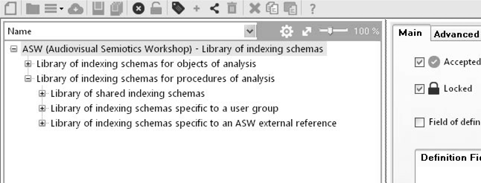
Figure 14.13 shows an extract from the library of schemas of indexing, made up of a set of collections of more specialized schemas of indexing. This library, notably, can be broken down into two perfectly complementary parts:
– a library of schemas of indexing reserved, as indicated in Figure 14.10, for the selection of such-and-such a conceptual term (in an interactive working form) which has to be analyzed; and
– a library of schemas of indexing for defining an analytical procedure or activity.
In our case, the library of schemas reserved for identifying a conceptual term is reduced to one and only one schema of selection or identification of a conceptual term – the schema of indexation entitled Analyze (“True”)/Do not analyze (“False”) this object. However, other schemas may be introduced to complement this on, such as schemas of quantification of the referent, or modal schemas (of modalities) facilitating a better definition of the conditions and modes of existence of a referent represented by a conceptual term and analyzed by the analyst, using the appropriate schemas of indexation.
However, the library of schemas of indexing reserved for defining analytical activities is highly elaborate and made up of a whole series of schemas of indexing facilitating very fine-grained and nuanced monitoring of that act so essential for analysis which is the appropriate entering of information (verbal, visual, acoustic, symbolic, etc.).
Figure 14.14. Extract from the library of schemas of indexation reserved for defining an analytical procedure

Thus, in the library of schemas of indexing for procedures of analysis (Figure 14.14), we can distinguish a collection of schemas of indexing reserved for the verbal indexing of a conceptual term or a configuration of conceptual terms defining a domain of knowledge thematized in an audiovisual text or corpus. This collection of schemas is divided into a series of more specialized collections (Figure 14.15): a collection of schemas of indexing reserved for entering proper nouns; a collection of schemas reserved for entering the expression of a conceptual term in the original language, etc.
A crucially important collection here is that called Schema of indexing of the minimal expression. This is the schema (or rather, the collection of schemas of indexing) which defines the only compulsory action which the analyst must carry out if he wishes to produce information relating to a given object using the procedure of free description*. In other words, the schemas belonging to this collection define the type of the activity of analysis [Minimal designation of the thematized object], of which – for the time being – there are two versions: a simplified version and a so-called standard version. The interface of the standard version is shown in Figure 14.12. It is made up of the two schemas of indexing (Figure 14.15): Entering of the minimal expression and Linguistic category (of the minimal expression). The simplified version of the analytical activity [Minimal designation of the thematized object], on the other hand, is defined only by the schema of indexing [Entering of the minimal expression – standard form].
Figure 14.15. Extract from the library of schemas of indexation reserved for verbal indexation
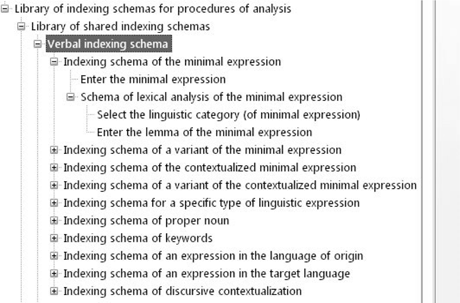
This little example shows how we tried to “marry” the seemingly very diverse needs, e.g. the need to be able to carry out simple and swift analyses with the need to be able to carry out in-depth, sophisticated analyses, tailored to specialized objectives. The ASW metalinguistic resources* indeed enable us to specify and develop descriptive models which comprise only one conceptual term, representing only one type of object and whose description is reduced to the activity [Minimal designation of the thematized object] in its simplified version – i.e. which only require the analyst to fill in one field in order to complete the analysis. They also enable us to develop highly sophisticated, “made-to-measure” models, passing through a whole panoply of models nearer to such-and-such a documentary practice or through descriptive models which rely on external references (standards, norms, etc.).
In Figure 14.15, we can distinguish other collections of schemas of indexing. A collection of schemas of indexing is specialized, for example, in visual or acoustic indexing, i.e. in the use of a meta-iconography which represents (illustrates, categorizes using a visual and/or acoustic “lexicon”) the content of an audiovisual text or corpus. Another collection of schemas of so-called textual indexing serves for drafting a textual annotation (see Figure 14.15).
A very significant collection in this library of schemas of indexing covers all those schemas of indexing which incorporate predefined terms or lists of terms, from which the analyst has to make a choice (in contrast to the schemas of verbal indexing discussed above which allow the analyst to freely produce an appropriate indexing). These schemas belong to the collection Schemas of indexing using the ASW thesaurus (Figure 14.14).
Figure 14.16. Extract from the library of schemas of indexing reserved for indexing using the ASW thesaurus
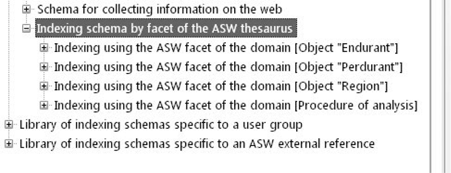
As Figure 14.16 shows, the collection entitled Schemas of indexing using the ASW thesaurus is highly diverse, and made up of a great many thematicallyspecialized schemas of indexing. Indeed, as we can see in Figure 14.16, there is one characteristic shared by all the schemas making up this collection, which is that they “point” to a range of predefined values in the ASW thesaurus. A range of predefined values is a semantic space which we call a facet and which corresponds to what Greimas termed a classeme, i.e. a semantic trait which (as the appellation suggests) classes together a certain number of values (standardized expressions, descriptors) in the thesaurus.
Figure 14.17. Collection of schemas of indexing by facet reserved for describing the taxonomic domain Linguistic object

Let us now take a brief look at Figure 14.17. This figure shows a specialized collection of schemas of indexing by facet, which form a set of metalinguistic resources for describing audiovisual texts that deal with an issue relating to “linguistic culture”: languages, families of languages, structures and uses of a language, writing systems, etc.
As we can see (Figure 14.17), we have selected a particular schema of indexing by facet entitled Identifying to value(s) of “Languages by alphabetical order”. This schema of indexation defines a type of activity of analysis* which belongs to a procedure of controlled description*, used to elaborate descriptive models* for analyzing audiovisual texts that thematize one or more languages (in a given context, in relation to such-and-such a use, such-and-such a group of speakers, etc.) and which belongs to one or more libraries* of descriptive models defining the universe of discourse* of a given audiovisual archive.
On the right-hand side of Figure 14.17, we see the expression (in uppercase) LANGUAGES BY ALPHABETICAL ORDER. This indicates the range of values, i.e. the facet of the ASW thesaurus (see Chapter 15) and which serves as a classeme for a certain number of (standardized) expressions.
For instance, <French> and <Nenets> are two standardized expressions which – like many others in the ASW thesaurus – come from the range or the facet Languages by alphabetical order. However, as we saw in Chapter 11, a standardized expression may constitute the value of two or more facets. Thus, <Nenets> also belongs to the ASW facet Ural languages and families of languages, in the same way as <French> is also found in the ASW facet Indo-European languages and families of languages.
We can clearly see that the facet expresses a classification, or a part of one, which may be scientific, practical, utilitarian, “popular”, etc. in nature. In other words, it enables us to explicitize the semantic trait or characteristic which an actor (a person, a social group, an institution) employs to group together things which another actor (another person, another social group, another institution) classifies in different categories.
1 This is done by an application invisible to the analyst that harvests data from Wikipedia – particularly the geographical coordinates needed to generate a location for entire videos and/or selected passages within a video on Google Maps.
2 See http://semiolive.ext.msh-paris.fr/ada/.
3 We refer here to Valérie Legrand-Galarza’s marvelous project, Patrimoine Culturel Immatériel Andin (http://semiolive.ext.msh-paris.fr/pcia – known as AICH, for Andean Intangible Cultural Heritage), created as part of two R&D projects: the French project ASASHS (ASW-HSS) and the European project Convergence http://www.ict-convergence.eu/).
4 This audiovisual documentation, created by Mouette Barboff (Association L’Europe, Civilisation du Pain), Elisabeth de Pablo and Richard Fillon (ESCoM-FMSH) in 2006 as part of the ARA program, can be consulted on the CCA (Culture Crossroads Archives) website: http://www.semiolive.msh-paris.fr/arc.
5 Concrete examples are to be found on the ARA (Audiovisual Research Archives) website: http://www.archivesaudiovisuelles.fr/FR/BilingualFolders.asp.
